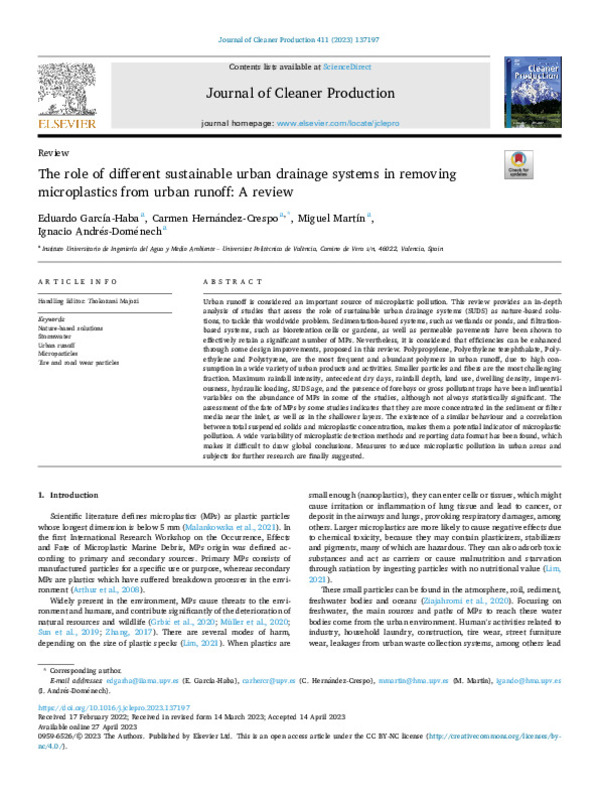JavaScript is disabled for your browser. Some features of this site may not work without it.
Buscar en RiuNet
Listar
Mi cuenta
Estadísticas
Ayuda RiuNet
Admin. UPV
The role of different sustainable urban drainage systems in removing microplastics from urban runoff: A review
Mostrar el registro sencillo del ítem
Ficheros en el ítem
| dc.contributor.author | García-Haba, Eduardo
|
es_ES |
| dc.contributor.author | Hernández Crespo, Carmen
|
es_ES |
| dc.contributor.author | Martín Monerris, Miguel
|
es_ES |
| dc.contributor.author | Andrés-Doménech, Ignacio
|
es_ES |
| dc.date.accessioned | 2023-12-20T19:01:05Z | |
| dc.date.available | 2023-12-20T19:01:05Z | |
| dc.date.issued | 2023-07-20 | es_ES |
| dc.identifier.issn | 0959-6526 | es_ES |
| dc.identifier.uri | http://hdl.handle.net/10251/200987 | |
| dc.description.abstract | [EN] Urban runoff is considered an important source of microplastic pollution. This review provides an in-depth analysis of studies that assess the role of sustainable urban drainage systems (SUDS) as nature-based solutions, to tackle this worldwide problem. Sedimentation-based systems, such as wetlands or ponds, and filtrationbased systems, such as bioretention cells or gardens, as well as permeable pavements have been shown to effectively retain a significant number of MPs. Nevertheless, it is considered that efficiencies can be enhanced through some design improvements, proposed in this review. Polypropylene, Polyethylene terephthalate, Polyethylene and Polystyrene, are the most frequent and abundant polymers in urban runoff, due to high consumption in a wide variety of urban products and activities. Smaller particles and fibers are the most challenging fraction. Maximum rainfall intensity, antecedent dry days, rainfall depth, land use, dwelling density, imperviousness, hydraulic loading, SUDS age, and the presence of forebays or gross pollutant traps have been influential variables on the abundance of MPs in some of the studies, although not always statistically significant. The assessment of the fate of MPs by some studies indicates that they are more concentrated in the sediment or filter media near the inlet, as well as in the shallower layers. The existence of a similar behaviour and a correlation between total suspended solids and microplastic concentration, makes them a potential indicator of microplastic pollution. A wide variability of microplastic detection methods and reporting data format has been found, which makes it difficult to draw global conclusions. Measures to reduce microplastic pollution in urban areas and subjects for further research are finally suggested. | es_ES |
| dc.description.sponsorship | This research has been developed within the ENGODRAIN (Ref. RTI2018-094217-B-C31) and SUDSLong-VLC (Ref. PID2021-122946OB-C32) projects, both funded by MCIN/AEI/10.13039/501100011033/and "ERDF Away of making Europe". Eduardo Garcia-Haba appreciates the pre-doctoral grant Ref. PRE2019-089409 funded by MCIN/AEI/10.13039/501100011033 and by "ESF Investing in your future". | es_ES |
| dc.language | Inglés | es_ES |
| dc.publisher | Elsevier | es_ES |
| dc.relation.ispartof | Journal of Cleaner Production | es_ES |
| dc.rights | Reconocimiento - No comercial (by-nc) | es_ES |
| dc.subject | Nature-based solutions | es_ES |
| dc.subject | Stormwater | es_ES |
| dc.subject | Urban runoff | es_ES |
| dc.subject | Microparticles | es_ES |
| dc.subject | Tire and road wear particles | es_ES |
| dc.subject.classification | TECNOLOGIA DEL MEDIO AMBIENTE | es_ES |
| dc.subject.classification | INGENIERIA HIDRAULICA | es_ES |
| dc.title | The role of different sustainable urban drainage systems in removing microplastics from urban runoff: A review | es_ES |
| dc.type | Artículo | es_ES |
| dc.identifier.doi | 10.1016/j.jclepro.2023.137197 | es_ES |
| dc.relation.projectID | info:eu-repo/grantAgreement/AEI/Plan Estatal de Investigación Científica y Técnica y de Innovación 2017-2020/RTI2018-094217-B-C31/ES/CARACTERIZACION AMBIENTAL DE SECCIONES FILTRANTES Y HERRAMIENTAS DE GOBERNANZA INTELIGENTE PARA UN DRENAJE URBANO SOSTENIBLE A ESCALA CIUDAD/ | es_ES |
| dc.relation.projectID | info:eu-repo/grantAgreement/AEI//PID2021-122946OB-C32//EVALUACIÓN A LARGO PLAZO DE SUDS MADUROS Y DE SU CONTRIBUCIÓN A LA MEJORA DE LA RESILIENCIA URBANA/ | es_ES |
| dc.relation.projectID | info:eu-repo/grantAgreement/MICINN//PRE2019-089409/ | es_ES |
| dc.rights.accessRights | Abierto | es_ES |
| dc.contributor.affiliation | Universitat Politècnica de València. Instituto Universitario de Ingeniería del Agua y del Medio Ambiente - Institut Universitari d'Enginyeria de l'Aigua i Medi Ambient | es_ES |
| dc.contributor.affiliation | Universitat Politècnica de València. Escuela Técnica Superior de Ingenieros de Caminos, Canales y Puertos - Escola Tècnica Superior d'Enginyers de Camins, Canals i Ports | es_ES |
| dc.description.bibliographicCitation | García-Haba, E.; Hernández Crespo, C.; Martín Monerris, M.; Andrés-Doménech, I. (2023). The role of different sustainable urban drainage systems in removing microplastics from urban runoff: A review. Journal of Cleaner Production. 411:1-13. https://doi.org/10.1016/j.jclepro.2023.137197 | es_ES |
| dc.description.accrualMethod | S | es_ES |
| dc.relation.publisherversion | https://doi.org/10.1016/j.jclepro.2023.137197 | es_ES |
| dc.description.upvformatpinicio | 1 | es_ES |
| dc.description.upvformatpfin | 13 | es_ES |
| dc.type.version | info:eu-repo/semantics/publishedVersion | es_ES |
| dc.description.volume | 411 | es_ES |
| dc.relation.pasarela | S\492220 | es_ES |
| dc.contributor.funder | European Social Fund | es_ES |
| dc.contributor.funder | AGENCIA ESTATAL DE INVESTIGACION | es_ES |
| dc.contributor.funder | European Regional Development Fund | es_ES |
| dc.contributor.funder | Ministerio de Ciencia e Innovación | es_ES |
| dc.contributor.funder | Universitat Politècnica de València |








